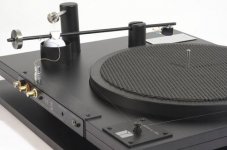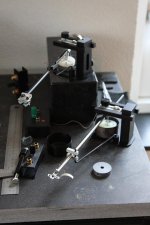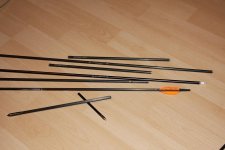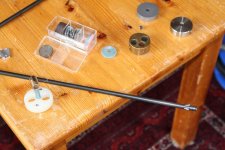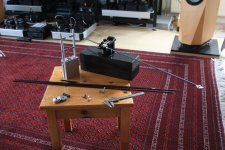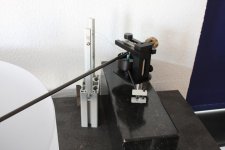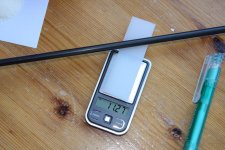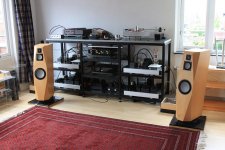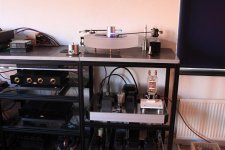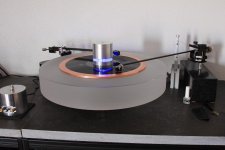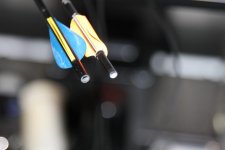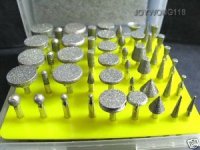Home made 17.7" Well Tempered Arm
Hello DIYAUDIO, as this is a WTA-thread i think it is appropriate to share my WTA-adventure here.
Some time ago i scored a great Scheu turntable platter + bearing. Typical German: outstanding manufacturing ! This platter weighs in at more than 17 kgs and when spinning at 33 1/3 it will take 5 minutes (!) to come to a standstill. The platter is 50 cm in diameter...so serious oversized. The encluded pictures do show a LP....not a single or EP.
Because of the size it is difficult to source correct tonearms. Only 12" tonearms with a very small baseplate do fit. So i started my search for longer. There are only a handfull of manufacturors making 14" tonearms (Clearaudio) or longer. And i was looking for 17" to 18". This would reduce offset-distortion to a minimum.
I already made quite some audio-gear (tube amplifiers etc) but because commercial stuff was not adequate i took up the chalange for a semi-selfbuild long tonearm.
Options:
- cardanic: for that i needed serious precise and complex working tools. And still have to much jitter in the bearings....discarded.
- Schroeder single filiment suspension: too nervous at those lengths.
- Single-point pivot bearing: possible. But the probability of a unsteady tonearm (at these lengths) would enforce me to use heavy outriggers.....leading to a heavy tonearm.
- WTA.....
WTA: i like them. Different; well thought; nicely crafted and.....possibilities to explore.
I found 2 very old WTA's and used them as donor-tonearms for my oversized experiment. Biggest problem was sourcing a good armwand/tube. It had to be light, stiff, inherent straigth, shielding ?, and....not exoticaly priced.
Arching is another hobby; why not use an arrow ? There are all kinds of arrows available all with different characteristics. I did some (resonance) experiments and found out:
- full carbon does give the best dampening but is only to be used for shorter lengths as this material is prone to bending.
- full aluminium is the most straigth and stiff but has a tendency to resonate.
- the mix aluminium hollow core + carbon sleeve is the best of both worlds.
But very nice: all arrows are by definition....straigth as an arrow !
After testing i eventually ended up with Easton ACC shafts. These are 30" long; too long for my needs as my Protractor only goes to 17.7". So that would be the tonearm-length.
Drilled some holes in the shaft for 2 teflon tubes (each containing the signal and ground wire for L and R). As this arm was that long i wanted an underslung counterweigth; easy to source on WWW. The jig of the original WTA is used although i made the silicone-oil bath moveable (just like the Reference WTA). For silicone-oil i used 40.000 CPS oil from a toy shop (normally used with radio controlled cars). They had a lot of different values (10.000 / 20.000 / 40.000 / 80.000 / 100.000) and after experimenting with the 17.7" arm i found the 40.000 the best. The complete arm was fixed to a slab of granite with a stainless steel pin attached to it.
It works like a charm. Absolutely no nervous resonance. Just like the original WTA i dampened the armwand. The Shelter 501MkII cartridge even performed better at the HiFi News resonance / torture tracks than a VPI arm !
With the Scheu / WTA combination i sold my VPI-turntable/arm very fast....... and enjoying the analog front end of the audioset.
Just to prove that the WTA system is great; and that it is possible to push the audio-boundaries a little bit further.
Regards, Reinout
(pictures include the original WTA's, the arrow shafts and work-in-progress)
Hello DIYAUDIO, as this is a WTA-thread i think it is appropriate to share my WTA-adventure here.
Some time ago i scored a great Scheu turntable platter + bearing. Typical German: outstanding manufacturing ! This platter weighs in at more than 17 kgs and when spinning at 33 1/3 it will take 5 minutes (!) to come to a standstill. The platter is 50 cm in diameter...so serious oversized. The encluded pictures do show a LP....not a single or EP.
Because of the size it is difficult to source correct tonearms. Only 12" tonearms with a very small baseplate do fit. So i started my search for longer. There are only a handfull of manufacturors making 14" tonearms (Clearaudio) or longer. And i was looking for 17" to 18". This would reduce offset-distortion to a minimum.
I already made quite some audio-gear (tube amplifiers etc) but because commercial stuff was not adequate i took up the chalange for a semi-selfbuild long tonearm.
Options:
- cardanic: for that i needed serious precise and complex working tools. And still have to much jitter in the bearings....discarded.
- Schroeder single filiment suspension: too nervous at those lengths.
- Single-point pivot bearing: possible. But the probability of a unsteady tonearm (at these lengths) would enforce me to use heavy outriggers.....leading to a heavy tonearm.
- WTA.....
WTA: i like them. Different; well thought; nicely crafted and.....possibilities to explore.
I found 2 very old WTA's and used them as donor-tonearms for my oversized experiment. Biggest problem was sourcing a good armwand/tube. It had to be light, stiff, inherent straigth, shielding ?, and....not exoticaly priced.
Arching is another hobby; why not use an arrow ? There are all kinds of arrows available all with different characteristics. I did some (resonance) experiments and found out:
- full carbon does give the best dampening but is only to be used for shorter lengths as this material is prone to bending.
- full aluminium is the most straigth and stiff but has a tendency to resonate.
- the mix aluminium hollow core + carbon sleeve is the best of both worlds.
But very nice: all arrows are by definition....straigth as an arrow !
After testing i eventually ended up with Easton ACC shafts. These are 30" long; too long for my needs as my Protractor only goes to 17.7". So that would be the tonearm-length.
Drilled some holes in the shaft for 2 teflon tubes (each containing the signal and ground wire for L and R). As this arm was that long i wanted an underslung counterweigth; easy to source on WWW. The jig of the original WTA is used although i made the silicone-oil bath moveable (just like the Reference WTA). For silicone-oil i used 40.000 CPS oil from a toy shop (normally used with radio controlled cars). They had a lot of different values (10.000 / 20.000 / 40.000 / 80.000 / 100.000) and after experimenting with the 17.7" arm i found the 40.000 the best. The complete arm was fixed to a slab of granite with a stainless steel pin attached to it.
It works like a charm. Absolutely no nervous resonance. Just like the original WTA i dampened the armwand. The Shelter 501MkII cartridge even performed better at the HiFi News resonance / torture tracks than a VPI arm !
With the Scheu / WTA combination i sold my VPI-turntable/arm very fast....... and enjoying the analog front end of the audioset.
Just to prove that the WTA system is great; and that it is possible to push the audio-boundaries a little bit further.
Regards, Reinout
(pictures include the original WTA's, the arrow shafts and work-in-progress)
Attachments
more pictures
Three more pictures of the 17.7" WTA arm:
- idea evolving;
- the wires are from the cartridge - through the armwand - via a "ladder-construction" (just to take care that the wires are not hindering horizontal arm-movement) - straigth to the preamplifier. No shielding; just copper transformer wires;
- the total weigth of the tonearmwand including dampening, teflon tubes, wires and headshell.
Reinout
Three more pictures of the 17.7" WTA arm:
- idea evolving;
- the wires are from the cartridge - through the armwand - via a "ladder-construction" (just to take care that the wires are not hindering horizontal arm-movement) - straigth to the preamplifier. No shielding; just copper transformer wires;
- the total weigth of the tonearmwand including dampening, teflon tubes, wires and headshell.
Reinout
Attachments
Hi,
Great !!! Thanks a lot for your pics.
Best regards,
Bins.
Great !!! Thanks a lot for your pics.
Best regards,
Bins.
Three final pictures:
- Scheu turntable at work (with the WTA arm and a original 12" Scheu arm at the backside)
- the complete audio-set.
Regards, Reinout
At 17" your putting alot of stress on that shaft to bend horizontally. Would not a wide rectangular balsa wood beam work out better both in mass and rigidity all around at that length?
Regards
David
Regards
David
Why not source some spiral wound carbon tube, they use it for trick kites and comes in up to 12mm tube, you'd not bend that over 17"
arrow shaft
Good afternoon all,
sq225917: the used shaft has a hollow aluminium core and than a (spirally wound) carbon sleeve is on top of that. And you're quite right: Easton shafts are also used for serious kites. But normally then it is 100% aluminium: different criteria.
Of course i could also choose for a larger diameter but this has 2 drawbacks: the weigth increases and the WTA - paddle construction would net to be redone (with the current 6 mm shaft i could use the standard paddle without modifications).
AVWERK: the horizontal stress is EXACTLY why i did not use (balsa)wood; combination aluminium + carbon is working great. Besides that in this wand i could insert the wires. That would be quite difficult with a wooden tonearm of this length. Or you do have very funny drills (i don't). So then you're stuck with attaching the wires on the outside of the arm.....not a nice solution.
In total the arm is 17.7 inch effective length + 4" on the "backside" for holding the counterweigth. I'm curious to know what a balsawood arm (6 mm diameter) at 21.7" will curve with a 10 grams cartridge and 70 grams counterweigth. I do know how the alu/carbon-combo curves: not !
That was one of the fun bits of using arrows: you can choose the "spine" of an arrow. That is the amount of flexibility each arrow has perpendicular on the length. The used material is important of course but also the tonearm-wall-thickness. And again options: there are more then 10 wall-thicknessess available.....take your pick with the following questions in mind: resonance / dampening / stiffness.
Included a picture of some used aroows. For the tests i simply used "second hand" arrows. An archer will discard an arrow after so many shots depending on the damage. These shafts were very usable for me. And when i found out my desired shaft: i bougth that item new (around $ 20).
You can see a full carbon shaft on the left and a aluminium/carbon combination on the rigth.
Reinout
Good afternoon all,
sq225917: the used shaft has a hollow aluminium core and than a (spirally wound) carbon sleeve is on top of that. And you're quite right: Easton shafts are also used for serious kites. But normally then it is 100% aluminium: different criteria.
Of course i could also choose for a larger diameter but this has 2 drawbacks: the weigth increases and the WTA - paddle construction would net to be redone (with the current 6 mm shaft i could use the standard paddle without modifications).
AVWERK: the horizontal stress is EXACTLY why i did not use (balsa)wood; combination aluminium + carbon is working great. Besides that in this wand i could insert the wires. That would be quite difficult with a wooden tonearm of this length. Or you do have very funny drills (i don't). So then you're stuck with attaching the wires on the outside of the arm.....not a nice solution.
In total the arm is 17.7 inch effective length + 4" on the "backside" for holding the counterweigth. I'm curious to know what a balsawood arm (6 mm diameter) at 21.7" will curve with a 10 grams cartridge and 70 grams counterweigth. I do know how the alu/carbon-combo curves: not !
That was one of the fun bits of using arrows: you can choose the "spine" of an arrow. That is the amount of flexibility each arrow has perpendicular on the length. The used material is important of course but also the tonearm-wall-thickness. And again options: there are more then 10 wall-thicknessess available.....take your pick with the following questions in mind: resonance / dampening / stiffness.
Included a picture of some used aroows. For the tests i simply used "second hand" arrows. An archer will discard an arrow after so many shots depending on the damage. These shafts were very usable for me. And when i found out my desired shaft: i bougth that item new (around $ 20).
You can see a full carbon shaft on the left and a aluminium/carbon combination on the rigth.
Reinout
Attachments
Dremel to the rescue
Good afternoon Capt Zach,
drilling in the shaft isn't that difficult when starting with small diameter drills and working your way up to 1.5 mm. Drilling under a very uncomfortable inclination was very difficult....and you need the holes absolutely NOT perpendicular to the shaft for that way the teflon tubes will bend too much (let alone have the problem of inserting the tubes easy....).
For that purpose i used a Dremel with all kinds of diamond tipped burs. Of course i practised with the used arrows but to be honest....it was quite easy.
Now i could start with making a small "dent" in the shaft and from there inserting/grinding with a bur under the required angle.
Total mechanical labour on the shaft:
- 2 holes in front for the teflon tubes;
- 2 holes near the paddle for the teflon tubes;
- 1 hole for fixing the headshell (the fingerlift is attached to the headshell itself);
- of course cutting the shaft to the correct length and grinding the endpart smooth.
The Dremel-burs are easy to obtain and don't cost a fortune altough the "diamond-name" suggest otherwise. Just check Ebay (where this picture is from).
Regards, Reinout
Good afternoon Capt Zach,
drilling in the shaft isn't that difficult when starting with small diameter drills and working your way up to 1.5 mm. Drilling under a very uncomfortable inclination was very difficult....and you need the holes absolutely NOT perpendicular to the shaft for that way the teflon tubes will bend too much (let alone have the problem of inserting the tubes easy....).
For that purpose i used a Dremel with all kinds of diamond tipped burs. Of course i practised with the used arrows but to be honest....it was quite easy.
Now i could start with making a small "dent" in the shaft and from there inserting/grinding with a bur under the required angle.
Total mechanical labour on the shaft:
- 2 holes in front for the teflon tubes;
- 2 holes near the paddle for the teflon tubes;
- 1 hole for fixing the headshell (the fingerlift is attached to the headshell itself);
- of course cutting the shaft to the correct length and grinding the endpart smooth.
The Dremel-burs are easy to obtain and don't cost a fortune altough the "diamond-name" suggest otherwise. Just check Ebay (where this picture is from).
Regards, Reinout
Attachments
Thanks for the info ReinoutdV.
I've been eyeing some of my cf tubes again because of your recent work. I was planning on building a new tonearm with one after I finish a current project. Cutting the shafts to length neatly was always something that bothered me. I guess I can always try the dremel technique.
I've been eyeing some of my cf tubes again because of your recent work. I was planning on building a new tonearm with one after I finish a current project. Cutting the shafts to length neatly was always something that bothered me. I guess I can always try the dremel technique.
Capt Zach,
If you're asking about cutting CF to length, a cheap ($5) hardware store tube cutter worked surprisingly well on golf club shafts.
If you're asking about cutting CF to length, a cheap ($5) hardware store tube cutter worked surprisingly well on golf club shafts.
Hi,
Finally, I received the carbon shafts for the arm. I am planning to try out the 9" arm. See the attachment for the details. Also, can we use the original arm flat disc concept (as explained in the patent paper) instead of the golf ball ? Please suggest.
Best regards,
Bins.
Finally, I received the carbon shafts for the arm. I am planning to try out the 9" arm. See the attachment for the details. Also, can we use the original arm flat disc concept (as explained in the patent paper) instead of the golf ball ? Please suggest.
Best regards,
Bins.
Attachments
I would like to ask you to attach a monofilament fishing line or a screw?
What kind of glue with help from, or in what way?
What kind of glue with help from, or in what way?
HI gents,
I am in the process of making a unipivot arm, But would also like to make the WTA with golfball, I have seen on Audiokarma site much info etc. but cant access the pics etc.
My question is How does one join the A K site ? as the question what does "LP" stand for has me stumped iv'e put in just about every combination but it just spits it back out
HELP
I am in the process of making a unipivot arm, But would also like to make the WTA with golfball, I have seen on Audiokarma site much info etc. but cant access the pics etc.
My question is How does one join the A K site ? as the question what does "LP" stand for has me stumped iv'e put in just about every combination but it just spits it back out
HELP
HI gents,
I am in the process of making a unipivot arm, But would also like to make the WTA with golfball, I have seen on Audiokarma site much info etc. but cant access the pics etc.
My question is How does one join the A K site ? as the question what does "LP" stand for has me stumped iv'e put in just about every combination but it just spits it back out
HELP
Good luck and enjoy both the project and the completed arm. WTAs are excellent arms. I built a clone of the original WTA years ago and used it for a very long time.
Bill Firebaugh mentions somewhere that WTAs require very little antiskate force. I would like to mention my thinking on the reason for this. Immerse an object in silicone fluid, the thicker the better and drag it through the fluid you will feel resistance. The faster and harder you push the greater resistance you will feel. At low speeds the fluid flows around the object easily.
With conventional pivoted tonearms the skating force is greater at the start of the record and lessens as the arm travels across the record. Attach an object to the arm and immerse it in silicone fluid and there will be resistance to the object moving through the fluid. As the skating force lessens with the position of the arm on the record the pushback of the fluid will diminish also. The dimples on the golf ball provide lots of little paddles pushing their way through the fluid and being pushed back less as the skating force diminishes. So the WTA has self regulating antiskate force. The initial antiskate force is set by the angle and rotation of the suspension strings. IMHO this is by far the best solution to the skating problem existing today. To my knowledge no body has advanced this analysis of antiskating in the WTA. Comments please.
BillG
- Home
- Source & Line
- Analogue Source
- Well tempered labs tonearm

